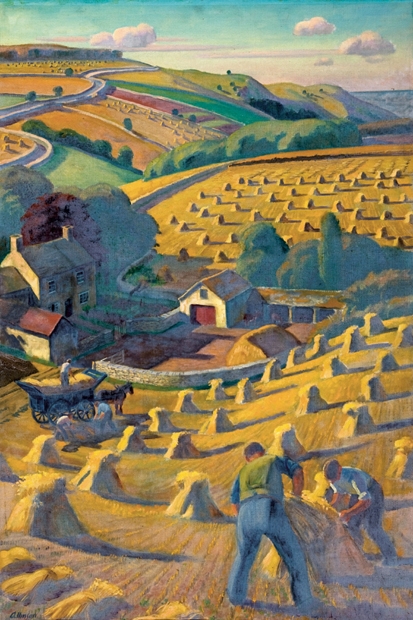‘Whither the novel’ was a great dinner party topic in the 1960s. It is a question less aired these days, when novels come in strange and varied forms. From Paul Kingsnorth’s The Wake, set in the 11th century andwritten in cod Olde Englisshe, to the versifying of Constantine Phipps (much chosen as ‘book of the year’), there is plenty to please us all.
Gardening books, however, have now reached the whithering stage. Samey, samey, samey is what they are, and this year even that most traditional of booksellers, Heywood Hill, has lamented the lack of anything new in the horticultural line. There are the inevitable huge picture books, the horticultural porn. The largest of these is Madison Cox’s The Gardener’s Garden (Phaidon £49.95, Spectator Bookshop, £44.95), which is so large I cannot carry it with one hand. It brims with pictures of gardens from all over the world.
George Plumptre’s The English Country House Garden (Frances Lincoln, £25, Spectator Bookshop, £20) shows examples of gardens which have often appeared in print, and I can pick it up at the same time as a cup of coffee. Zooming in even smaller, to focus on one garden, Roy Strong’s account of the changes at his own place, Remaking a Garden: The Laskett Transformed (Frances Lincoln, £30, Spectator Bookshop, £25) leaves one with a bit more to think about. Should gardens change? Sir Roy thinks they should, and proves it with action shots of trees and hedges being grubbed out, colonnades being built and grasses being introduced to borders where once old-fashioned flowers bloomed.
Sarah Raven in her book Vita Sackville-West’sSissinghurst (Virago £30, Spectator Bookshop, £24) wants more of what Vita wanted. Her grandmother-in-law was strong on flowers. (Roy Strong says, ‘Remember, flowers in a garden are a sign of failure’). I liked being reminded of Vita’s collected Observer articles, which were what I read avidly when I started to garden, and a friend who had never come across Sackville-West’s writing was delighted to find so much good advice about the growing and choosing of plants.
How others do it never goes out of fashion. Is it fair to say that serious gardeners like reading about what you can do to make your garden more beautiful and productive, while less serious gardeners crave ‘isn’t it luvverly’ pictures? Putting myself in the first camp, I want to add The Garden Anthology (Frances Lincoln, £16.99, Spectator Bookshop, £14.99) edited by Ursula Buchan to my bookshelves. This consists of articles that have appeared in the RHS magazine The Garden. It is a good read on so many topics. Weather, plants, science design, pests and diseases, wildlife, people. Anyone who gardens will find something to interest them, and this is a nicely designed book, with illustrations rather than photographs, which can be read in bed. The profits from the book will go to RHS Enterprises ‘to promote horticulture and help gardeners’, so it is a Thoroughly Good Thing. I hope I can say that, even though I had better admit to being one of the writers included.
Another manual which I want to keep is a slim volume from Charles Dowding who has revolutionised the way we grow vegetables, by the no-dig method. He is the arch experimenter and discarder of old techniques. Gardening Myths and Misconceptions (Green Books £9.99, Spectator Bookshop, £8.99) questions conventional wisdom, so that I found myself saying really? out loud several times. The book consist of short statements: ‘Seeds and plants need really fine soil for sowing and planting’, followed by a Dowding pronouncement — in this case ‘mostly untrue’ — and he then expands to say that even carrots can cope with lumps. I learned a lot from this book.
The whithering garden reader might be tempted by a bit of history. I have always been puzzled by the American devotion to our plants and style of growing them. America’s Romance with the English Garden by Thomas J. Mickey (Ohio University Press, £17.99, Spectator Bookshop, £15.99) puts it all down to late 19th-century seed catalogues. But it was interesting to learn that Alexander Pope influenced the gardens of Williamsburg, and that one of the earliest colonial gardening books, written to tempt more settlers to Virginia, claimed that ‘a kitchen garden don’t thrive better or faster in any part of the universe than here’.
Growing food is the subject of Caroline Foley’s Of Cabbages and Kings (Frances Lincoln, £20, Spectator Bookshop, £16). Described on the cover as a history of allotments, it is much more the well-told story of the English labourer’s struggle for land. The early chapters on tithes, villeins and serfs make good background reading for The Wake. The Tillage Act in 1563 aimed to prevent the conversion of arable to pasture ‘in order to curb idleness, drunkenness and all other lewd practices’. (This is a recurring theme in the social history of gardening. Ralph Austen, a Calvinist Proctor of Oxford University wrote a treatise on fruit trees, pointing out the connections between good husbandry and the good life. Dean Hole established a cottage garden society ‘that has reclaimed many a waste place from sterility and many a sot from the beerhouse’.) Allotments only make an appearance half way through Of Cabbages and Kings, but the gallop through the history of useful rather than ornamental crops makes a refreshing change from stately gardening.






Comments